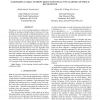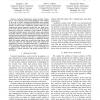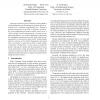1369 search results - page 60 / 274 » Lattice computations for random numbers |
ICASSP
2009
IEEE
14 years 3 months ago
2009
IEEE
We propose a new active learning algorithm to address the problem of selecting a limited subset of utterances for transcribing from a large amount of unlabeled utterances so that ...
Publication
Traffic measurements on a ring local area computer network at the Massachusetts Institute of Technology are presented. The analysis of the arrival pattern shows that the arrival pr...
AUTOMATICA
2011
13 years 15 days ago
2011
The concept of elementary flux vector is valuable in a number of applications of metabolic engineering. For instance, in metabolic flux analysis, each admissible flux vector ca...
IROS
2007
IEEE
14 years 3 months ago
2007
IEEE
Abstract— Temporal classification, such as activity recognition, is a key component for creating intelligent robot systems. In the case of robots, classification algorithms mus...
CVPR
2006
IEEE
14 years 11 months ago
2006
IEEE
This paper presents a generic method for solving Markov random fields (MRF) by formulating the problem of MAP estimation as 0-1 quadratic programming (QP). Though in general solvi...



